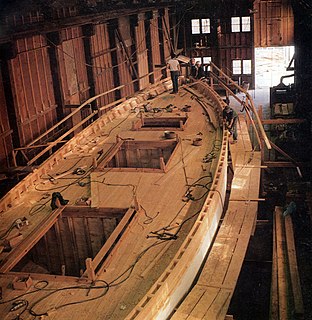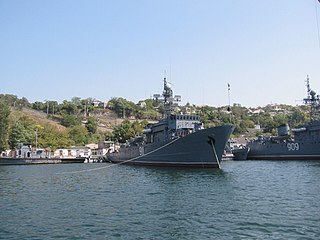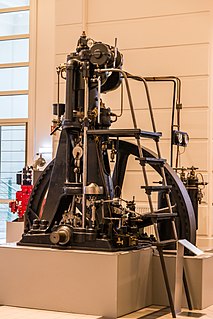
A frigate is a type of warship, having various sizes and roles over the last few centuries.
The United States Navy, United States Coast Guard, and United States National Oceanic and Atmospheric Administration (NOAA) use a hull classification symbol to identify their ships by type and by individual ship within a type. The system is analogous to the pennant number system that the Royal Navy and other European and Commonwealth navies use.

A naval mine is a self-contained explosive device placed in water to damage or destroy surface ships or submarines. Unlike depth charges, mines are deposited and left to wait until they are triggered by the approach of, or contact with, any vessel. Naval mines can be used offensively, to hamper enemy shipping movements or lock vessels into a harbour; or defensively, to protect friendly vessels and create "safe" zones.

A minesweeper is a small naval warship designed to engage in minesweeping. Using various mechanisms intended to counter the threat posed by naval mines, waterways are kept clear for safe shipping.

An ironclad is a steam-propelled warship protected by iron or steel armor plates used in the early part of the second half of the 19th century. The ironclad was developed as a result of the vulnerability of wooden warships to explosive or incendiary shells. The first ironclad battleship, Gloire, was launched by the French Navy in November 1859. The British Admiralty had been considering armored warships since 1856 and prepared a draft design for an armored corvette in 1857; in early 1859 the Royal Navy started building two iron-hulled armored frigates, and by 1861 had made the decision to move to an all-armored battle fleet. After the first clashes of ironclads took place in 1862 during the American Civil War, it became clear that the ironclad had replaced the unarmored ship of the line as the most powerful warship afloat. This type of ship would come to be very successful in the American Civil War.

A warship or combatant ship is a naval ship that is built and primarily intended for naval warfare. Usually they belong to the armed forces of a state. As well as being armed, warships are designed to withstand damage and are usually faster and more manoeuvrable than merchant ships. Unlike a merchant ship, which carries cargo, a warship typically carries only weapons, ammunition and supplies for its crew. Warships usually belong to a navy, though they have also been operated by individuals, cooperatives and corporations.

A gunboat is a naval watercraft designed for the express purpose of carrying one or more guns to bombard coastal targets, as opposed to those military craft designed for naval warfare, or for ferrying troops or supplies.

Boat building is the design and construction of boats and their systems. This includes at a minimum a hull, with propulsion, mechanical, navigation, safety and other systems as a craft requires.

The Bangor-class minesweepers were a class of warships operated by the Royal Navy (RN), Royal Canadian Navy (RCN), Imperial Japanese Navy (IJN), and Royal Indian Navy (RIN) during the Second World War.

The Ton class were coastal minesweepers built in the 1950s for the Royal Navy, but also used by other navies such as the South African Navy and the Royal Australian Navy. They were intended to meet the threat of seabed mines laid in shallow coastal waters, rivers, ports and harbours, a task for which the existing ocean-going minesweepers of the Algerine-class were not suited.

USS Peacock (AMS/MSC-198) was a Bluebird-class minesweeper in the United States Navy for clearing coastal minefields.

A fishing vessel is a boat or ship used to catch fish in the sea, or on a lake or river. Many different kinds of vessels are used in commercial, artisanal and recreational fishing.

The Royal Naval Patrol Service (RNPS) was a branch of the Royal Navy active during both the First and Second World Wars. The RNPS operated many small auxiliary vessels such as naval trawlers for anti-submarine and minesweeping operations to protect coastal Britain and convoys.

A naval trawler is a vessel built along the lines of a fishing trawler but fitted out for naval purposes. Naval trawlers were widely used during the First and Second World Wars. Fishing trawlers were particularly suited for many naval requirements because they were robust boats designed to work heavy trawls in all types of weather and had large clear working decks. One could create a mine sweeper simply by replacing the trawl with a mine sweep. Adding depth charge racks on the deck, ASDIC below, and a 3-inch (76 mm) or 4-inch (102 mm) gun in the bow equipped the trawler for anti-submarine duties.

The Natya-class were a group of minesweepers built for the Soviet Navy and export customers during the 1970s and 1980s. The Soviet designation was Project 266M Akvamarin. The ships were used for ocean minesweeping.
The Sasha class is the NATO reporting name for a class of minesweepers built for the Soviet Navy between 1954 and 1956. The Soviet designation was Project 265

A naval drifter is a boat built along the lines of a commercial fishing drifter but fitted out for naval purposes. The use of naval drifters is paralleled by the use of naval trawlers.
Rautu and Vilppula were Kljuz class Minesweepers left by the Soviets to Finland in 1918 since they would not have survived the harsh sailing to the Leningrad. Ships had weak hulls and their engines were not particularly powerful. During peacetime they were used as depot and test ships. Vilppula was designated as T-2 and Zashtshitnik and Rautu as Murman before they were included to the Finnish Navy
Type 912 degaussing/deperming ship is a class of degaussing/deperming ship of the People's Liberation Army Navy (PLAN) with many derivatives. Type 912 is also the most numerous degaussing/deperming ship in PLAN.

The Fugas class were a group of minesweepers built for the Soviet Navy in the 1930s and 1940s. The Soviet designations were Project 3, Project 53, Project 53-U and Project 58.


















